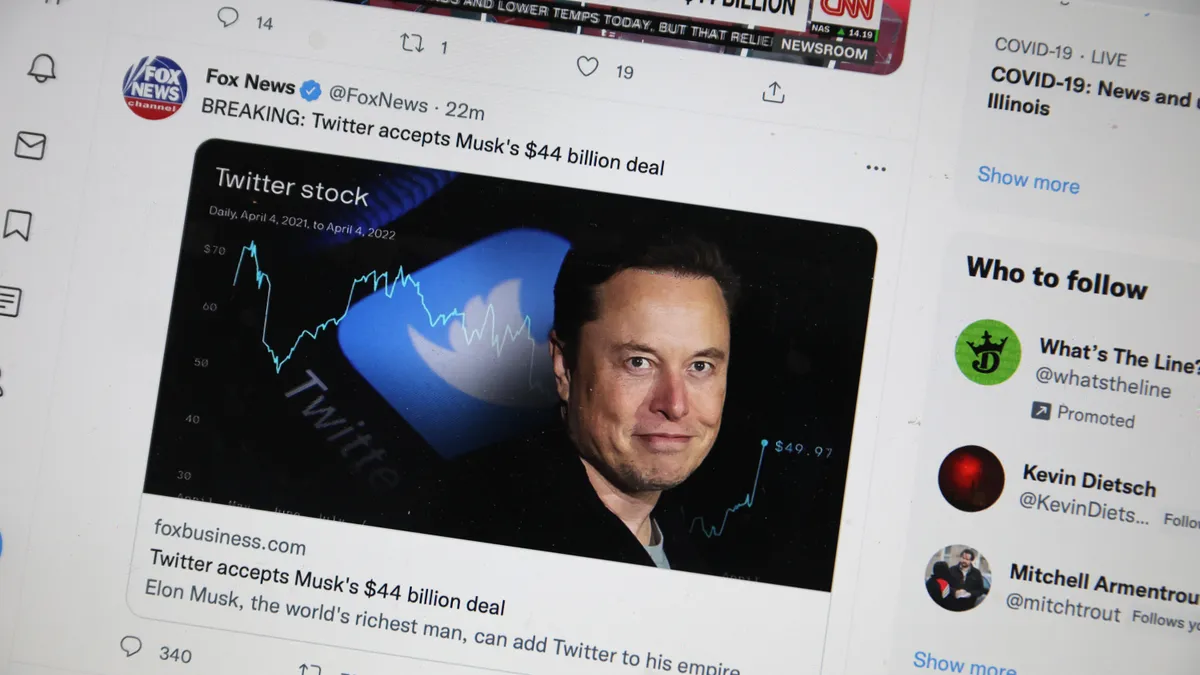Dive Brief:
- Twitter’s advertising prospects were on the decline months before Elon Musk completed his takeover and brands announced media freezes, according to a new MediaRadar analysis shared with Marketing Dive.
- The ad-tracking firm found that the app’s advertiser pool increased between April and May, in the weeks immediately following the deal’s announcement, but has largely dipped since then. The total number of brands running media on Twitter dropped from 3,900 in May to 2,300 in August, before ticking back up slightly to 2,900 in September.
- Before July, Twitter attracted more than 1,000 new advertisers per month. That figure plunged to around 200 in July and August before briefly jumping back up into the 600 range in September, a period where it was less clear whether the Musk deal would go through.
Dive Insight:
Musk’s first week at the Twitter helm has sparked a fresh round of controversy, with a rash of executive exits and renewed concerns over brand safety and security that have led major advertisers and agencies to step back from the platform. MediaRadar’s analysis indicates many in the industry anticipated a chaotic transition and began cutting their investments as early as the spring. That timeline also aligns with intensifying macroeconomic pressures that have impacted marketing budgets and harshly affected the social media category, in particular.
Not only has Twitter seen its general advertiser pool dip amid the Musk rigamarole, per MediaRadar, it’s also struggled to attract new brands into the fold that might replace the ones pulling back. Regardless of the reasoning behind the exodus, the trend poses a serious challenge to Musk, who needs to right a ship that derives the lion’s share of its revenue — about 90% — from advertising.
If Twitter’s brand appeal was already slipping before the takeover was completed, Musk has done little to rectify the situation since a formal transition began last week. Some of his ideas for new business drivers beyond ads, like making users pay to keep their verified badges, have drawn pushback.
On the platform itself, the Tesla and SpaceX entrepreneur has tweeted posts from websites known for spreading misinformation and gotten into spats with high-profile accounts — behavior that’s at odds with the reassurances around fostering a warm and welcoming environment that he’s promoted to brands at large. As Twitter’s CEO, he’s shaken up the executive ranks, with Twitter in the past week losing a CMO and global ad sales lead that were an important bridge to Madison Avenue. Twitter today began making more extensive layoffs to cut costs.
Brands have not been shy about their view on Twitter at the moment. General Motors confirmed it is taking a temporary paid media pause. The automaker, which competes with Tesla, has spent about $15.6 million on Twitter so far this year, according to MediaRadar. IPG’s Mediabrands and Havas are advising their clients to take a similarly cautionary approach. General Mills, Mondelez International, Audi and Pfizer have also hit the Twitter brakes, The Wall Street Journal reported.
Mass social media spending freezes and boycotts are not uncommon. Facebook has been subject to a handful due to data privacy and hate speech-related issues, while YouTube was infamously the catalyst for an “Adpocalypse” back in 2017. But Facebook and YouTube are not run by executives who love to troll and position themselves as “free-speech absolutists.” The question now is whether Musk can rein in some of his more inflammatory tendencies or lose out on trust.
“The pullback is very reminiscent of what we saw in the past with YouTube,” said MediaRadar CEO Todd Krizelman in a statement. “Advertisers publicly paused due to controversy and returned when they had confidence their brand safety concerns were addressed. It will be interesting to see how Twitter responds.”















